The Doppler effect applies to both sound waves as well as light waves. So let us first analyze what the doppler effect of light is.
The Doppler effect of light is defined as the change in the frequency of light viewed by the observer as a result of the relative motion of the observer and the source of light. As a result, we can say that the doppler effect in light occurs in the same way as it does in sound.
So, now that we know about the doppler effect in light, we will look into the relativistic doppler effect, its formula, its real life examples, and much more in this article.
How does the doppler effect work with light?
Light always travels at the same speed regardless of the frame of reference used; the only change is in its energy. So, let us look at how the Doppler effect works with light.
The wavelength of light determines the energy of light. Thus, while the source and observer are moving relative to one another, the wavelength of the light that the source emits changes when it is perceived by the observer. This phenomenon is referred to as the Doppler effect.
Doppler effect for light examples:
The phenomenon of the Doppler effect in light occurs in real life. Let us see it through the examples given below:
- Because of the universe’s expansion, the light we get from distant objects (such as stars) is redshifted.
- The speed of the car passing by is measured by a speed camera using the Doppler effect of light.
The relativistic doppler effect for light:
The Doppler effect in the light is seen due to the relativistic motion of the observer and the source. So let us look more closely at the relativistic doppler effect in the light.
The observer gets the wave with frequency f or wavelength ???? when the source and observer are both stationary. Assume a light source in the frame emits light of wavelength ????s in time ts and moves away from the stationary frame at speed v. (assumed constant).
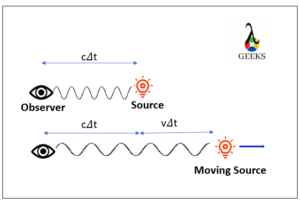
According to special relativity theory, changes in time and length intervals rely on the observer’s relative motion. Thus, by applying the Lorentz Transformation equation to a relatively moving frame of references, we obtain the following equation for the wavelength as measured by the observer:
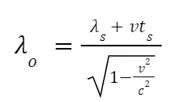
(When ???? = ᥆, then ????o = ????s)
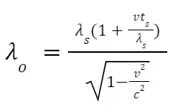
But, ???? / t = c (Where, c is the speed of light)
Thus, the above equation can be written as:
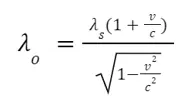
By simplifying above equation we get the wavelength observed by the observer:

This equation assumes that the source is moving away from the observer. Hence, the velocity v is positive when the source moves away from the observer and negative when the source moves towards the observer.
This equation can be expressed as follows in terms of the source frequency and observed frequency:
fo = c / ????o
Thus,
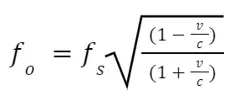
Equations (1) and (2) are the required equations for the Doppler effect.
Redshift & Blueshift:
Light’s frequency defines its color. A change in frequency of the source and observer caused by their relative motion is a redshift and blueshift. Let us look at what it means.
- As the light source moves away from the observer, the observer receives a lower frequency wave than the source. The fact that red color has the lowest frequency in the visible spectrum produces a shift to the red end of the spectrum. It is known as the redshift in astronomy.
- As the source of light moves closer to the observer, the observer receives a higher frequency wave than the source. The fact that blue color has the highest frequency in the visible spectrum produces a shift to the blue end of the spectrum. It is known as the blueshift in astronomy.
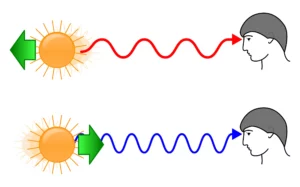
Conclusion:
This article shows us that being a wave light also experiences the Doppler effect, just like sound does. This phenomenon occurs due to the relative speed of the light emitter and the observer. We get to the idea that the universe is expanding thanks to the Doppler effect of light.
Also Read:
- Effect of wavelength on refraction
- Ozone layer depletion effects
- Doppler effect examples
- Effect of refraction on frequency
- Effect of refraction on wavelength
- Robot end effector

I am Alpa Rajai, Completed my Masters in science with specialization in Physics. I am very enthusiastic about Writing about my understanding towards Advanced science. I assure that my words and methods will help readers to understand their doubts and clear what they are looking for. Apart from Physics, I am a trained Kathak Dancer and also I write my feeling in the form of poetry sometimes. I keep on updating myself in Physics and whatever I understand I simplify the same and keep it straight to the point so that it deliver clearly to the readers.